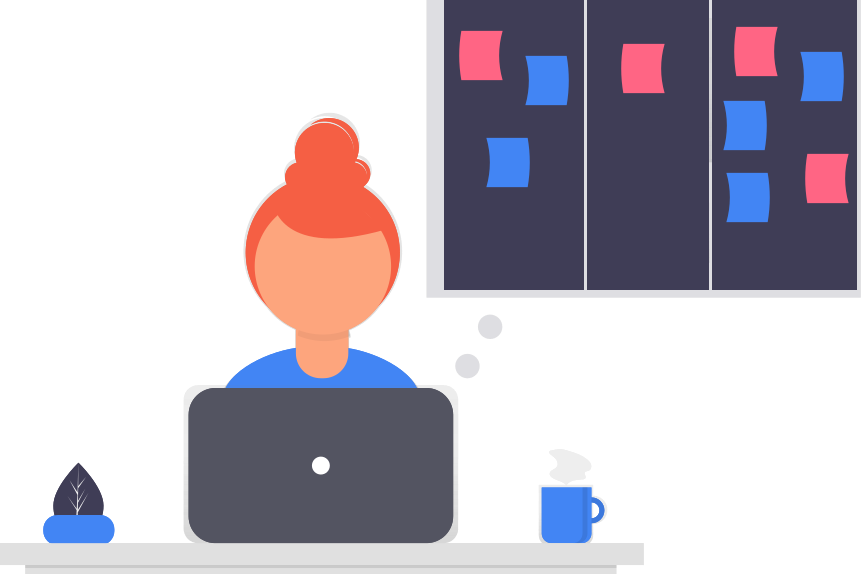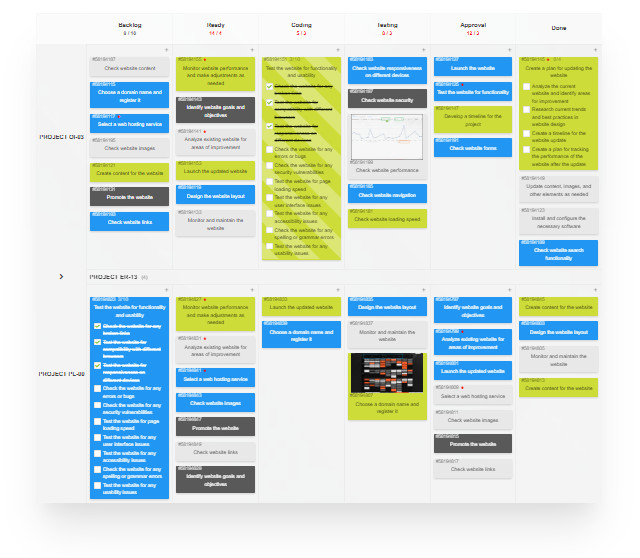What is Kanban Software?

Kanban software applies the practices of Kanban to help teams, departments, and companies to project manage their work. The software delivers Kanban boards with columns and lists to help teams create backlogs, select items, visualize and manage the flow, and pull performance data.
More than just a digital Kanban board
Although much of the project management software available in the market looks like it might support Kanban project management, only the applications that adhere to the innate Kanban routines can be considered a total Kanban solution. Typically, when we think of Kanban software, the first thing that comes to mind is ..a digital Kanban board. The board itself - although at the center of the application - is not the sole feature of Kanban software. Complete systems will also have the following characteristics:
- Powerful visual cues, allowing you to read data at a glance through custom card views, various card colors, and icons
- Built-in Work in Progress Limits, helping to minimize multitasking and increase process throughput
- Intelligent engines, that help you set due dates and reminders and create automation rules that control card behavior on the board, through underlying scripts
- Intuitive interface and design, that distinctly shows the progress and status of work
- The ability to handle multiple projects or workstreams through the means of swimlanes - horizontal rows
- Insightful reports that show work performance and highlight areas for improvement, i.e. the Cumulative Flow diagram or the Lead and Cycle Time
- Integration interfaces, that allow you to interact with team members email, coding repositories, or other third-party apps
- Security of your data. If your team is distributed across many offices, or when you’re employing remote workers, a secure online Kanban software will be ideal. However, if you have sensitive data that you cannot send to the cloud, you should consider having a secure On-Premise Kanban software installed on your servers.
- Mobile access, providing a continued view of your workflow regardless of where you are and what device type you have on hand.

Leverage the power of remote teams
Often, company team members are distributed due to either remote working or to multiple office locations. In such cases, the use of physical boards will be limited, or two separate boards would be maintained, causing status synchronization problems, which defeats the point of using the boards in the first place. For these teams, digital boards are the obvious way to go.
Unlimited space for your data
When team members’ seating space is limited, or when processes are complex, physical boards can also be constricting. Not all team members can see the board, or the board cannot present all the relevant information. By comparison, a virtual board is accessed simply via a web browser and scales limitlessly to contain all your data. On the other hand, there is no danger of facing a forever scrolling, endless digital board - an online Kanban should let you collapse the portions of the workflow that you’re not interested in and filter for the data relevant to your immediate need.
Did you know?
Kanban Tool® software supports individual and small projects work, as well as complete processes of corporations. Take advantage of the service’s simplicity of use, and store all your files, data, and project work in one, easy to navigate place. Give it a try!
Open to process changes
Evolving processes mean that teams will periodically need to change their ways of working, requiring them to update the number of columns on the board, reorder them, or even re-build the board from scratch. Software solutions cater to this very well, whereas redesigning physical boards is usually a chore big enough to make the team think twice about implementing a process alteration. That, in turn, hinders improvement in the long run! Thanks to how easy it is to change a digital Kanban board’s layout, you really can have the board work for you, and not the other way round.
Superior reporting
Physical Kanban boards are the easiest way of introducing teams to Kanban. But they will never provide the reporting abilities of Kanban software. Tracking performance across the last months or years is not possible with an analog board. Furthermore, the speed at which data can be built and distributed to shareholders via Kanban software is far superior to attempting to do the same through a physical board.
What are the gains of using Kanban software, then?
- A collaboration space for everyone on the team, no matter where and when they work
- Unlimited space for your process data: descriptions, checklists, file attachments, links, etc.
- Clear status insight and automatic process analysis for managers
- Easier project scaling and templates recycling
- Time-saving and waste reduction, thanks to not having to update a physical board and an instant data share with all of the team members
Are there any drawbacks to using digital Kanban?
While using online boards is objectively easier, some prefer having the satisfaction of physically moving actual sticky notes on a Kanban whiteboard. You could also argue that if a co-located team uses a virtual board, it may force them to not communicate in person as much, potentially weakening the team bond. But these matters deal more with personal preference and attitude rather than the merits of using a form of teamwork software that best supports the collaboration.
We encourage you to try both approaches to see what works for your team. It’s common for teams new to Kanban to use a physical board to start with, as culture-change facilitation, and later move on to virtual boards. Once the Kanban method itself becomes their standard way of tracking work, and the team’s scope of work and Kanban uses exceed the space and capability of wallboard, they should be ready to move the flow to a digital solution.